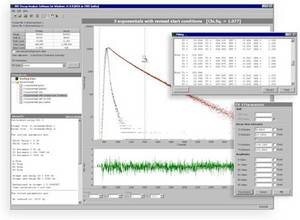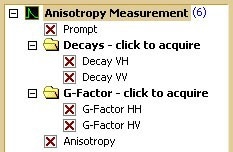The FluoroMax® series represents HORIBA's industry-leading fluorometer performance in a convenient, easy-to-use, affordable benchtop model. The FluoroMax family was the first to introduce a tabletop fluorescence instrument with the sensitivity of a modular fluorometer with its novel all-reflective optics and photon counting technology.
Even though it is a small spectrofluorometer, it has features that are uncommon in table-top fluorescence detection systems and the highest level of sensitivity for fluorescence investigations.
The FluoroMax Plus, the most recent version of the original, high-performance tabletop fluorometer, belongs to the FluoroMax series. It provides extended performance by detecting emission spectra out to 1700 nm and Time-Correlated Single Photon Counting (TCSPC) lifetime measurements as short as 25 ps.
The spectrofluorometers in the FluoroMax series are excellent for measuring both solid and liquid samples.
Five Generations of Success: Cary Davies on the Roots of the FluoroMax+ Video. Video Credit: HORIBA Scientific
Features
- Powerful FluorEssence™ software for Windows®
- Phosphorimeter accessory for long-lived luminescence determinations
- Photon counting for the ultimate sensitivity
- Method files to recall complete experiment parameters
- Water Raman signal-to-noise ratio: 10,000:1 (FSD method)
- Time-correlated single-photon counting (TCSPC) accessory for lifetime determinations
- Fast Scanning capability - up to 80 nm/second
Hardware
The Source
With the help of an elliptical mirror, the xenon source that provides the best UV performance is concentrated onto the entrance slit of the excitation monochromator. In addition to making sure that all wavelengths are focused on the slit, the reflective surface guarantees effective collection.
To enable phosphorescence studies, an additional, software-selectable xenon flash lamp can be installed.
The Slits
The slits themselves are continuously and bilaterally adjustable from the computer in bandpass or millimeter units. This allows for maximum resolution and immediate reproducibility to be maintained.
The Excitation Monochromator
The excitation monochromator is an aspheric design that ensures that the image of the light diffracted by the grating can fit through the slit.
The gratings themselves are plane, blazed gratings that prevent the two main drawbacks of the more prevalent concave holographic gratings: poor polarization performance and insufficient imaging during scans that waste light.
The distinctive wavelength drive scans the grating at up to 80 nm/second. The grating grooves are blazed to provide the most UV and visible light possible.
The Reference Detector
A photodiode reference detector measures the intensity as a function of time and wavelength before the excitation light reaches the sample. Compared to the older, conventional rhodamine-B quantum counter, the photodiode detector has a wider wavelength response and does not require any maintenance.
The Sample Chamber
A spacious sample chamber is provided as standard to enable the user to use a variety of accessories for special samples and encourages the user to make use of a variety of sample schemes.
The Emission Monochromator
The emission monochromator incorporates all the exceptional qualities of the excitation monochromator. To provide the greatest throughput in the visible range, gratings are blazed.
The Emission Detector
Photon-counting is used by emission detector electronics to achieve the highest level of low-light detection. While ignoring smaller signals coming from the detector tube, photon counting focuses on signals that come from fluorescence emission (PMT).
The more popular analog detection technique (used by fluorometers with lower performance) simply combines noise and signal to cover up weak emissions.
An integral high-voltage supply that is factory programmed to provide the signal-to-noise ratio is also included in the emission detector housing.
Computer Control
The FluoroMax can be controlled from a PC using FluorEssence™ software, which is then transmitted via a USB link. The system automatically calibrates itself upon startup and makes itself available for new experiments or routines that have been stored and are quickly called from memory.
Accessories
The majority of accessories are interchangeable with the FluoroMax system and come in a wide range of applications-focused varieties.
FluorEssence Steady State Software
FluorEssence™ for Windows® sets a new standard for fluorescence software. FluorEssence™ connects spectrofluorometer data acquisition directly to the renowned Origin® software processing power.
Users can choose a scan type or accessory or bring back an entire experimental set-up with just a few simple clicks.

FluorEssence - Steady State Software. Image Credit: HORIBA Scientific
Revolutionize the Way Users Operate Their Spectrofluorometer
- Automatic correction for blanks and lamp output
- Free video tutorials make FluorEssence™ even easier to master
- Run a variety of accessories including polarizers, microwell-plate readers, temperature baths, autotitrators, phosphorimeters, and more
- Change units for temperature, wavelength, and slit-width with the click of a mouse
- Simplified windows make data acquisition intuitive, even to the inexperienced user
- With detector algebra, assemble input signals from different detectors into unique equations (including arithmetic or transcendental functions) that produce data in a format tailored to your application
- Select the special Real Time Control (RTC) window to optimize run parameters before scanning is commenced
To simplify the operation of the laboratory, FluorEssence™ also includes the robust processing and data-management tools of Origin®.
Data-viewing, plotting, processing and management are all available, which include extensive import and export facilities, view manipulation and creation, arithmetic applications, peak-picking and integration, data- management, etc.

Image Credit: HORIBA Scientific
Software Features
- Contour maps and profiles from 3D plots
- 3D perspective
- Normalization
- Zooming and scaling
- Deconvolute
- Blank subtraction
- Excitation/emission correction
- PLQY calculator wizard (for use with Quanta-Phi accessory)
- Smoothing
- Standard arithmetic
- Integration/DerivativeFit fluorescence data to Gaussian, Lorentzian, and custom curves
- Data views in Workbook formats, keeping graphs, tables, and notes together for each experiment
- Interpolation and extrapolation
DAS6 Decay Analysis Software
By fitting the raw decay data to one of several kinetic models, HORIBA Scientific’s decay analysis software is able to extract kinetic information (such as fluorescence lifetime and rotational correlation times) from luminescence decay data.

Image Credit: HORIBA Scientific
Features such as shift iteration and reconvolution of instrument response function (IRF, or "lamp" profile) allow for the accurate recovery of multiple decay components even when the decay data is grossly distorted by the IRF.
DAS6 is intended to speed up the analysis of time-domain luminescence data while still allowing for parameter fine-tuning when required. In addition to the analysis of more specialized fluorescence decay processes, analysis modules also include reconvolution analysis of multi-exponential models.
Multi-Exponential
Five or more exponentials can be analyzed.
Batch Exponential
Batch mode is perfect for applications where large amounts of lifetime data are generated, such as lifetime imaging and reaction monitoring, as it supports datasets containing up to 10,000 decays. It has shift iteration and full reconvolution with up to five exponentials.
Global Exponential
Global analyses can be performed on 100 decay curves and up to five exponential components.
Distribution
Two methods are available for performing lifetime distribution analysis. The first method employs a “Top Hat” distribution function which allows a single lifetime distribution to be fitted in conjunction with an additional discrete lifetime. The second method is an optional module that will perform a Non-Extensive Decay distribution which allows up to five lifetime distributions to be modeled.
Exponential Series
Exponential series analysis of up to 30 terms is possible. This means that it is possible to parameterize otherwise challenging data.
Foerster Energy Transfer
Energy transfer using the 2D and 3D Foerster type with an optional exponential component is doable.
Yokoto-Tanimoto Energy Transfer
Yokoto-Tanimoto energy transfer can be carried out with the option of an exponential component while accounting for diffusion.
Micellar Quenching
The surfactant aggregation number can be determined using micellar quenching kinetics.
Exciplex
Exciplex analysis is the step that follows on from the formation of an excited state species.
Anisotropy Analysis
Impulse reconvolution of up to two correlation times and five components of fluorescence decay. Each model parameter, including shift, can be fixed at a pre-determined value or optimized as part of the parameter fitting.
Even when the observed decay is severely distorted by the length of the excitation pulse, the use of reconvolution enables accurate determination of decay times and rotational correlation times.
DataStation TCSPC Acquisition Software
DataStation is the newest measurement environment for time-domain fluorescence and comes as standard with all HORIBA Scientific lifetime systems.

Image Credit: HORIBA Scientific
Lifetime systems are made up of various modules and parts, such as focusing optics, motorized polarizers, monochromators, PMTs, pulsed light sources, and MCAs. All of these components are controlled by DataStation through a single mouse-driven, logical Windows environment.
Lifetime systems are capable of carrying out a wide range of measurement tasks, including temperature scans, time-resolved emission scans (TRES), steady-state spectra, time-resolved anisotropy measurements, fluorescence decay measurements, phosphorescence decay measurements, and more.
Using DataStation, these measurements are now routine. Automated data acquisition is carried out using computer-controlled components, and measurement templates are supplied to instantly set up the instrument for the necessary measurement.
The data that has been acquired can be exported or copied to the clipboard for manipulation using a third-party application and saved in a variety of formats, including the .das format, HORIBA Jobin Yvon IBH v4.2, and ASCII. It can also be printed using a Windows printer.
For use on systems other than those made by HORIBA Scientific, DataStation can be purchased separately. Custom functionality and interfacing (such as those for additional monochromator types, motorized polarizer holders, etc.) can also be added.
When used in conjunction with FluoroHub, the DataStation software thrives.
Functionality
DataStation is constantly changing as new features are added in response to user suggestions. Outlined below is a partial list of said features:
Graphical
- Multiple mouse zoom modes-x only, y only, x and y, pan, reset
- Intuitive tree navigation for files and hardware settings
- Real-time estimated average lifetime during acquisition
- Detachable and customizable toolbars with helpful hints
- Log or linear y-axis
- Context-sensitive pop-up toolbars
- Tree navigation control window for FluoroHub control
- Reversed time-axis mode (automatically reverses data during reversed-TAC mode measurements)
- Auto-scaling y-axis
- Live display of cursor position, peak count, peak channel, and total count

Image Credit: HORIBA Scientific
TCSPC Mode
- Multiple on-screen simultaneous traces
- Measurement presets - peak count or elapsed time
TRES Mode
- Records 3D data (counts vs. time vs. wavelength) with live 3D progress display and interactive rotation
- Configure the instrument for scan operation in just a few mouse clicks
- Manual and automatic data slicing
- Scan excitation or emission monochromator
Anisotropy Mode
- G-factor measurement
- Target difference count
MCA Support
- EG&G/Perkin Elmer Ortec Trump card
- Canberra/Tennelec PCA3
Monochromator Support
Polarizer Support
- PRA polarizers
- HORIBA Scientific 5000U-02 polarizers
Temperature Control Support
- Cryostat (as an accessory to HORIBA Scientific 5000 series system only)
- HORIBA Jobin Yvon IBH dipstick temperature controller (as an accessory to HORIBA Scientific 5000 series system only)
System Requirements
To run DataStation, the user’s computer must meet the requirements listed below. The attached spectrometer hardware determines the measurement’s functionality. A compatible MCA card or FluoroHub is necessary for basic operation. For more information, get in touch with HORIBA Scientific.
1 Gb RAM, 1 Gb HD space, DVD drive, 1024x768 graphics with minimum 256 color support, mouse or other pointing devices. Windows™ XP or later (XP/Vista/7). Windows™ XP recommended.